The Ultimate Guide to GMAT Functions Problems? (Probably not, but it’s a start…)
Just want all of this as a 20-page PDF?
The GMAT Functions GuideThere are few words that strike terror into testtakers more than “functions.”
Wait for it…
Yeah, that feeling. The dropping in the pit of the stomach, the hyperventilating. We’ve all been there.
Let’s not waste time trying to make functions sound simple or appealing; you don’t have to like them! You just need to learn a few actionable techniques to getting past them.
What is a Function?
Does it matter?
A little bit, but only to this degree: a function is just an equation. You know, you take a number and you feed it into the equation and then it poops something out the other end and you have an answer.
Well, “function” is just a clever word for the exact same thing, but just slightly rearranged!
Let’s say that I take the value of

is when x = 3.
Pretty easy, right? You’d just replace the x with the 3 and that would give you this:

So that’s pretty straightforward, right? If it’s not, shoot me an e-mail and I’ll see if I can help out.
Now let’s phrase it like this:

Let’s solve this tremendously complicated progresion of our idea:
Move up six lines and do the exact same thing you did before: replace the x with a 3.
Yup, kids, that’s a function. That’s all. When you get an f (3) or f (5) or f (37) you simply replace the x with whatever is now within the brackets, then continue the calculation.
ASIDE:
Practice SAFE X (sorry!): when replacing the x, always surround the new number with brackets.
Back to the lecture…
That is, if we have:

and the testwriters ask what f(3) is, it is written like this:

Do you really need to do this? I guess you don’t have to, but a lot of algebra is learning how to mitigate risk. In a complicated situation like this one…
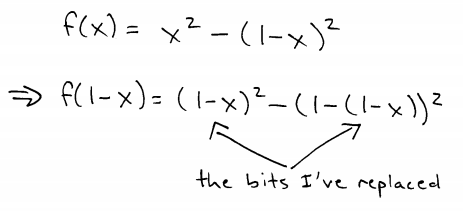
…it becomes useful to know where exactly you’ve replaced things, yes?
So in the end it’s up to you, but don’t come crying to me when you tripped over a negative sign and fell on your face.
As a note, you might be wondering why this doesn’t have technical f(x) notation. It’s still a substitution question–in a few pages, we will address how any substitution question can be written as a function!
Another Way to Look at GMAT Functions Questions
You know that program that Microsoft created for no other reason than to confuse the living shit out of people called “Excel?”
Or perhaps you use Excel every day and it’s only my practical-ass mind simply can’t wrap my head around its silliness. Hey, if you like the Excel, this will be great for you.
Look at it this way: a function is basically just an Excel macro written on the page.
To go back to our original example, if you’re given f(3), that’s the same as simply putting a 3 in a column associated with the macro:

That’s obviously going to give this:

Done. Dusted.
Attack of the Over-Complicated GMAT Functions Problems
You know how function explanations always talk about “Domain” and “Range?” Fuck that shit.
(Yes, even if you learned it for SAT. This is one place where the GMAT is easier than the SAT. Forget that stuff: it is useless.)
You really don’t need to know the terminology, so my prescription is to ignore it with prejudice.
Sometimes, however, it’s useful to have a tool to rely upon…
In more complicated functions questions, I suggest drawing a table. All you need to do is to think about the INPUT and the OUTPUT.
INPUT (feeding): x
OUTPUT (pooping): f(x)
Scatology aside, it’s a pretty useful device to remember how a function works, isn’t it?
Which Input Equals Which Output?
There’s another variant in GMAT Fucntions problems where you’re asked to find which function has the same output for multiple inputs.
As an example, let’s revisit the table above. The question related to it might ask whether you’ll get the same output for f(x) and for f(x+1).
In a case like this, a table becomes particularly useful:

Now we have all of the information laid out. But what does it mean? All the information in the world won’t do any good if it’s not clear what we’re supposed to do with it.
Think about it like this: if multiple inputs give the same output, that means that in the table above, the left side will equal the right side. In four cases, the two sides won’t match.
What we’re looking for is the answer choice where f(x) and f(x+1) give the same output. That is, in only one case, they’ll be equal.
Let’s look at an example of an Official GMAT Functions problem
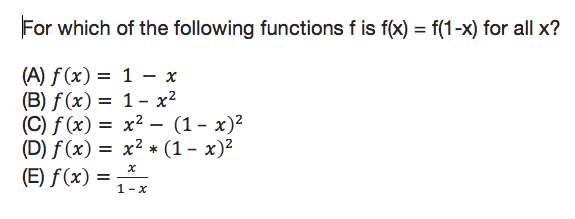
Now let’s look at multiple different variations of GMAT functions problems.
There are a number of ways that the GMAT can present a functions question. Let’s look at a few of the variations on this theme…
GMAT Functions problems that involve “evens only.”
These are a particularly annoying species of functions question, but luckily the inflection point for this question is actually fairly simple.
If you get a function where f(n) is the product of all the even integers from 2 to n, it is good policy always to factor out the two. This will tell you more clearly what factors you’re actually dealing with.
Take a look at this example:
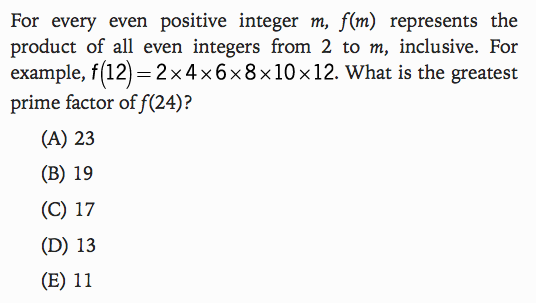
If you want extra credit, check out the explanation here–which is part XI of the Properties of Numbers Guide–for the theory behind a particularly nasty 700-level functions question.

Let’s look at another nice and ugly GMAT functions problem:
This one is just lunacy. The fact that it’s expressed as a function is pretty much arbitrary–except that adding function notation into the mix just makes life a bit more shitty for the testtaker.
However, once you unpack what the hell it’s actually talking about you’ll see that it’s really not that bad.
Trying to write out an explanation is just an exercise in futility, so watch the video already.
The key in this question is simply to functions question is basically as irrelevant as calling any particular algebra question a “function.”
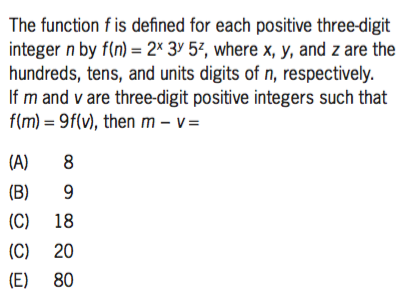
A Note: Functions with Different Letters
Another significant problem with GMAT Functions questions is that the Official Guide is a bit scattershot about what it labels a “function” question and what it doesn’t.
That is, the back of the Official Guide might not classify a question as a functions question even when the question clearly involves function notation such as h(t) or f(n)! As a minor note, pay attention to the fact that a functions question doesn’t necessarily have to use f(x)–generally, it’s some letter, a set of parentheses, and a some variable inside of these parentheses.
That doesn’t change how the function works. Just treat it as if it’s f(x).
To eliminate this annoyance, you can think about it this way: realistically, any Algebra-based question can be translated into a function.
Just Treat All GMAT Algebra Questions as Functions Problems
(From this, it will become clear that functions are just basic Algebra questions!)
Let’s look at a brief example:
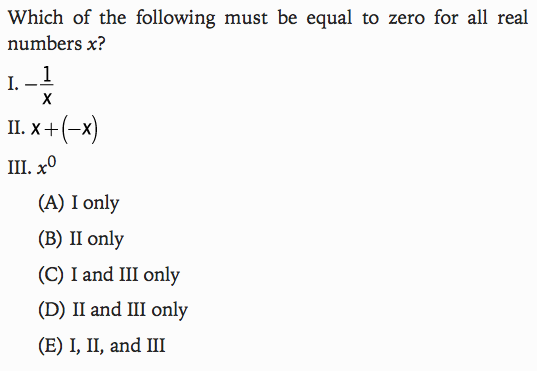
We could simply rewrite this question as:
For which of the following functions is f(x) equal to zero for all real numbers x?
Then you’d see something like this:
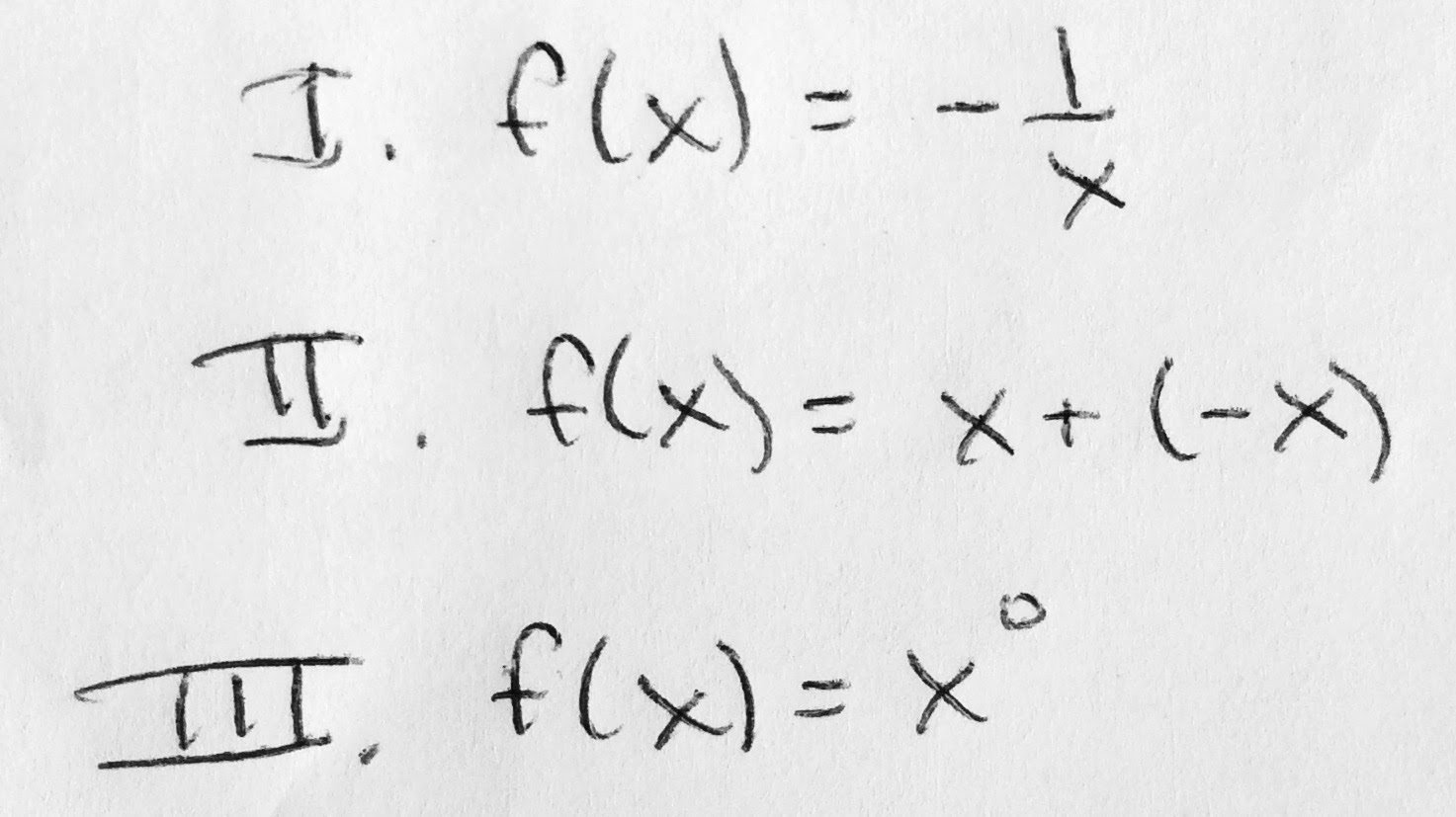
Let’s take a look at this using our trusty substitution. Just try a handful of numbers and see if they shake out to zero.
Statement I gives us f(2)=-1/(2). Nope, not zero. Remember that if it’s for all values of x, then one violating case is enough to disprove, so we’re done. Do we need to try another? OK, just for practice: f(7)=-1/(7). Nope, still not zero.
But what about if I make x zero?
Yeah, no. That gives us this: f(0)=-1/(0). Remember, dividing by zero does not zero make.
Remember, having zero on the bottom of a fraction is the Bad Thing in GMAT-world. For our purposes having a zero on the bottom is total nonsense.
Given the rules of GMAT math, it’s impossible; in other words, this means -1(0) cannot be equal to zero, because by the boundaries of the question, zero must be a possible outcome of the function. And it’s not here, obs.
Statement II gives us f(2) = (2) + (-(2)) = 0. Ooh, this looks promising. Try a couple more if you’re not sure. f(7) = (7) + (-(7)) = 0. Yup. f(412) = (412) + (-(412)) = 0. Looks like this one’s a winner.
Note: adding the opposite of any number will always yield zero, so you don’t really have to plug in here unless you’re really uncertain.
Statement III gives us f(2)=20=1. In fact, any number raised to the zero power is one! Since one isn’t zero, this statement won’t work.
Thus the answer is B: Statement 2 only.
Let’s look at another example:
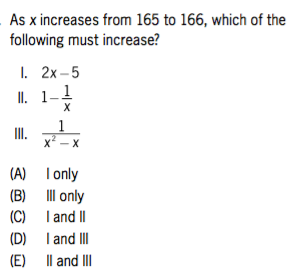
Remember, the only thing you actually have to do in this question is to replace each of the x-terms with 165, then 166.
That is, I. 2(165)-5 and then I. 2(166)-5, etc.
From this it’s quite clear that the the first statement will be true because we’re simply increasing the number. That’s a YES.
The third statement is also fairly easy, because we’re actually increasing the denominator. That means you’ll be dividing by a larger number, which definitely makes the result smaller. That’s a NO.
The second statement, however, introduces some problems: we are definitely decreasing the 1xterm. However, because we’re subtracting that, we are actually increasing the term 1-1x. That’s a YES.
Too much? Watch the video–this may have to be seen to make better sense.
Weird Symbols
Note that sometimes you don’t even have to have strict function notation!
If you get a weird symbol that is defined within the question–that is, it says the symbol “means that” or is “defined as “–this is nothing more than a function: yet again, a command to substitute!
(Note: please try to avoid getting in your own way here!
It’s not just some math thing “you’re supposed to know but never learned”. If it says “means that” or “defined as,” just accept what they’re telling you the damn definition is and work with it!)
(note that we’ve seen one of these before, so it’s not so bad!)
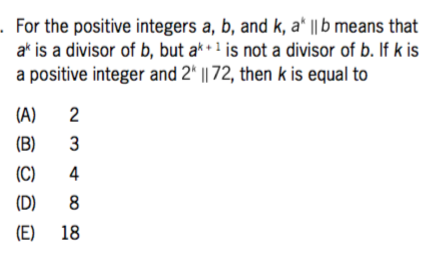
Note that sometimes you don’t even have to have strict function notation!
If you get a weird symbol that is defined within the question–that is, it says the symbol “means that” or is “defined as “–this is nothing more than a function: yet again, a command to substitute!
(Note: please try to avoid getting in your own way here! Just because you see a symbol you’re not familiar with, that doesn’t mean that it’s “just some math thing I’m supposed to know but never learned”. If it says “means that” or “defined as,” just accept what they’re telling you the damn definition is and work with it!)
All you have to do is to figure out what and where to substitute:
Looking at this question, note that the brackets aren’t really brackets! They’re actually a Weird Symbol! Egads, it’s a Function question after all.
Check out the video for the explanation!
GMAT Functions and Physics Questions
Yeah, yeah, the name is scary. Fine.
Let me tell you, though–physics-based math questions are great! There’s no room for the GMAT to mess with your head because they’re rooted in things that we can more or less take for granted, like gravity or the fact that distance = rate * time…
That is, if you drop a pen it will fall; if you drive sixty miles an hour for one hour, you’ve driven sixty miles. Not even the GMAT can figure out a way to mess with that.
All we need to do with this type of question is to figure out what physical concept the question is actually talking about, then work on how the function actually relates to that concept.
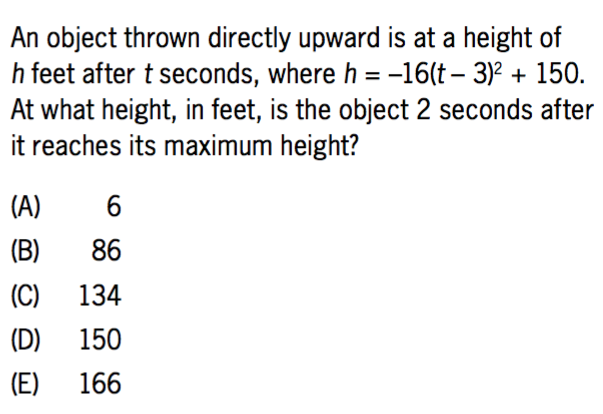
Stacked GMAT Functions Questions
What do I mean by Stacked Functions?
That’s situations where you have an f(x)–or, in this case, a Weird Symbol–and you have to apply that function on different levels, depending on different locations within the brackets and sub-brackets.
There’s no real trick to brackets and sub-brackets except to tread carefully. Remember Russian Dolls have to be opened layer-by-layer. You’re not going to get them to fit if you use the fat base with the skinny top, right?
If you’re feeling particularly clever today, you might recognize that a Russian Doll is taken apart from the outside in.
However, let’s think about that a slightly different way. If you were to construct rather than destruct the doll, you’d find that you do work from the inside out.
The key to a Stacked Functions question is ALWAYS to work from the inside out.
That is, take the inside brackets and calculate those first.

As a note, let’s discuss how we would do this. You could watch the video, obviously, but here is the basic structure.
1) look at the left side inside bracket: 98Θ33, which yields remainder 32
2) this makes the left side now 32Θ17, which yields remainder 15
3) the left side is thus 15
4) look at the right side inside bracket: 33Θ17, which yields remainder 16
5) this makes the right side now 98Θ16, which yields remainder 2
6) we know that the left side is 16 and the right side is 2, implying 16-2 =13.
See? It’s not that hard at all when you break it down.
AND… that’s it. The last of the Functions Course. Do you know any other types of Functions Questions that you’d like to address?
What’s a good practice for the future? I suggest figuring out what types of GMAT questions you can turn into Functions questions, just to get used to the f(x) notation.
Remember, any Algebra question can be interpreted as a Functions question!
“Real World” Examples in GMAT Functions Questions
Quite simply, functions are used quite often in the real world. It’s just an issue of “if you put a variable x here, it will come out somewhere else changed by whatever (function, Excel macro, Slip ‘n’ Slide)” we’ve placed that variable x into.
Bearing that in mind, it’s not at all surprising that GMAT questions will involve theoretically real-world examples of functions.
However, before you start worrying about candles and profit margins and all that crap, I suggest giving the question a more thorough read:
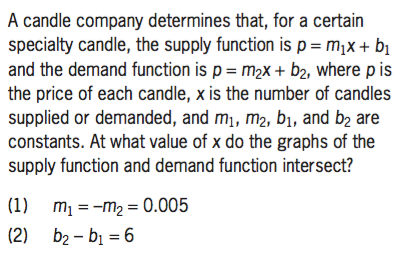
Wait–so the x that makes supply = demand? Like p = p? Shit, man, that’s all you had to say. Why make it look so difficult?
Because Professor GMAT got you thinking about candles and other nonsense; not about the practicality of the mathematical circumstance.
Remember, Functions questions are supposed to be easy! They’re blowing a bunch of smoke in your face trying to confuse you, but it ALWAYS boils down to something quite simple.
Check out the video for the full explanation.
AND… that’s it. The last of the Functions Course. Do you know any other types of Functions Questions that you’d like to address?
What’s a good practice for the future? I suggest figuring out what types of GMAT questions you can turn into Functions questions, just to get used to the f(x) notation.
Remember, almost any Algebra question can be interpreted as a Functions question! You can practice anywhere, any time!
